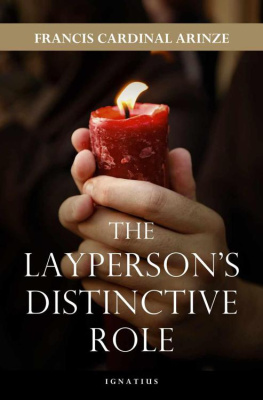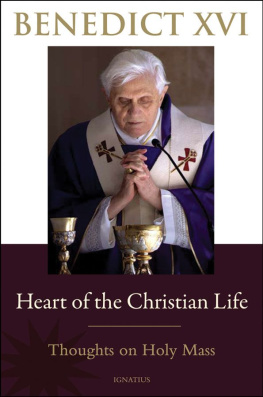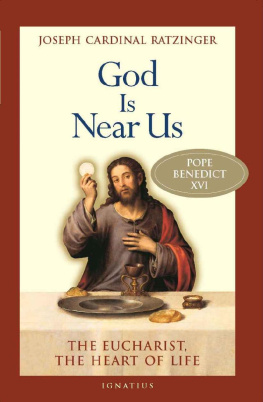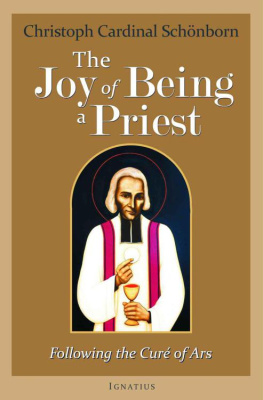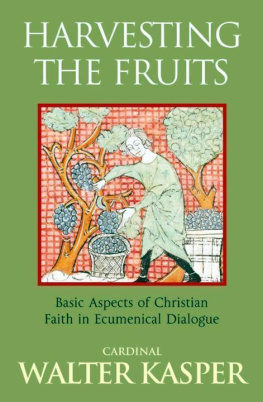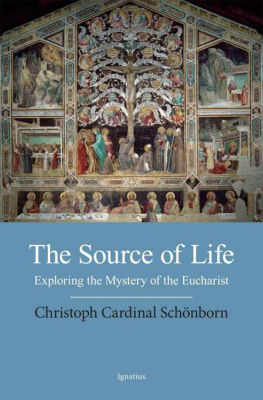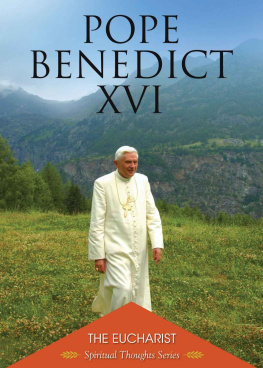CELEBRATING THE HOLY EUCHARIST
FRANCIS CARDINAL ARINZE
CELEBRATING
THE HOLY
EUCHARIST
IGNATIUS PRESS SAN FRANCISCO
Cover art: The Last Supper (detail)
Ste. Chapelle, Paris
Art Resource, New York
Cover design by Roxanne Mei Lum
2006 Ignatius Press, San Francisco
All rights reserved
ISBN 978-1-58617-158-2
ISBN 1-58617-158-5
Library of Congress Control Number 2006921885
CONTENTS
PREFACE
The Eucharistic celebration occupies a central place in the prayer life of the Church and, therefore, of every member of the Church. The Church herself takes her origin from the paschal mystery of the suffering, death, and Resurrection of Christ. When she celebrates this mystery in the Holy Eucharist, she is at the high point of her public worship. She also finds herself, in the Eucharistic celebration, at the fount from which all her power flows.
The priest is ordained in the first place to celebrate the Sacrifice of the Mass and then to carry out other liturgical rites, to preach the Word of God, and to gather the people of God together. He is at the summit of his vocation when in persona Christi he celebrates the Eucharistic Sacrifice.
The lay faithful and men and women of the consecrated life in its many forms find in the Eucharistic celebration the fount and apex of their entire Christian lives and the spiritual powerhouse from which their apostolates are given life, meaning, and a sense of direction.
I have therefore accepted the request of several friends to prepare the following reflections on the celebration of the Eucharistic mystery. Most of these meditations have been proposed to various congregations in seminars, congresses, or homilies in the past three years. In view of the Year of the Eucharist that was concluded in October 2005 with the XI Ordinary Assembly of the Synod of Bishops, the theme seems of particular relevance. But even independently of this Year of the Eucharist, the celebration of the Eucharistic mystery remains of prime importance in our lives as followers of Christ. In a sense, we can never say enough about the Holy Eucharist.
Without, therefore, pretending to say anything entirely new, I offer the following reflections for the use of priests, deacons, men and women of the consecrated life, and the lay faithful. I hope that these theological, pastoral, and liturgical considerations may help improve the quality of their various contributions to the celebration of the Holy Mass and their veneration of the Holy Eucharist outside Mass.
This book begins with a reflection on the Holy Eucharist as sacrifice and sacrament, on the importance of faith on our part, and on the necessity of reverence due to our Blessed Lord in this mystery. Reverence also calls for some periods of silence and contemplation during the Eucharistic celebration.
Every Christian has a role in the celebration. Thoughts are directed to the roles of the diocesan Bishop, the celebrating priest, and the liturgical assembly in general. The active participation of all the baptized will be examined together with its necessary bodily dimension. Temptations to exaggerate will also be mentioned.
Not a few changes have been introduced in liturgical rites especially in the past forty years. A general look at them with reference to the Mass will be useful. Here we will consider the place of adaptation and inculturation with regard to Mass and the importance of observing established liturgical norms.
The Eucharistic celebration sends Christians on mission, to evangelize. Deserving of special mention is the role of the family, apart from that of individuals, in this evangelizing mission.
The veneration of the Holy Eucharist outside Mass has found many expressions in the life of the Church, especially of the Latin Rite. It should therefore be discussed.
In order to appreciate fully and to live out the centrality of the Eucharist in their faith, all Christians need ongoing scriptural and liturgical formation.
These reflections, prepared in August 2005, have been enriched with insights from the XI Assembly of the Synod of Bishops, which met in the Vatican City in October 2005.
May our Blessed Mother Mary, Woman of the Eucharist (EE 53), obtain for us the grace to grow in our Eucharistic faith and in ever deeper sharing in the Eucharistic celebration.
Vatican City
Solemnity of Christ the King, 2005
WHAT THE CHURCH TEACHES
ON THE HOLY EUCHARIST
The Holy Eucharist, says the Second Vatican Council, contains the Churchs entire spiritual wealth: Christ himself, our passover and living bread (PO 5; see also EE 1). In considering, therefore, the celebration of this spiritual treasure, it is fitting that we begin with a listing of Gospel and other New Testament passages along with some major documents of the Magisterium on the Holy Eucharist.
New Testament and Magisterial Documents
In the Gospel according to John, chapter 6, Jesus promises us the Holy Eucharist and teaches us its key place. Three accounts of the institution are to be found in Matthew 26:26-29; Mark 14:12-16, 22-26; and Luke 22:19-20; and another in 1 Corinthians 11:23-26.
The major liturgical books on the Eucharistic celebration are the Roman Missal , third typical edition of 2002 (with 1,318 pages!), and the lectionary.
The major corpus of teaching of the Catholic faith regarding the Holy Eucharist by an ecumenical or general council is that of the Council of Trent (1545-1563), especially as recorded in DS 1725-60. The Second Vatican Council (1962-1965) also gave precious considerations, teaching, and directives on the Holy Eucharist and its celebration in Lumen Gentium and Sacrosanctum Concilium .
The Catechism of the Catholic Church , as an up-to-date compendium of what the Church believes and teaches, supported by papal authority, will be found to be a special guide, especially in articles 1322 to 1405.
Among papal documents in the last sixty years, allow me to mention the three Encyclical Letters Mediator Dei by Pius XII in 1947, Mysterium Fidei by Paul VI in 1965, and Ecclesia de Eucharistia by John Paul II in 2003. Three Apostolic Letters of the last-named Pope are also on the Holy Eucharist: Dominicae Cenae in 1980, Dies Domini in 1998, and Mane Nobiscum Domine in 2004.
It is also useful to study the five following documents of the Congregation for Divine Worship and the Discipline of the Sacraments: Eucharisticum Mysterium in 1967, Eucharistiae Sacramentum in 1973, Directory on Popular Devotion and Liturgy in 2002, Redemptionis Sacramentum in 2004, and Suggestions and Proposals for the Year of the Eucharist in 2004.
Holy Eucharist: Sacrifice: Memorial of Our Redemption
At the Last Supper, the night before he gave his life for us on the Cross, our Lord Jesus Christ took bread, gave thanks, and said to his Apostles: This is my Body given for you. He did the same with the cup after supper and said: This cup is the new covenant in my blood poured out for you (Lk 22:9-20). Jesus gave to his Apostles his Body to eat and his Blood to drink. Then he added: Whenever you drink it, do this as a memorial of me (1 Cor 11:25). And Saint Paul explains to the Corinthians: Whenever you eat this bread, then, and drink this cup, you are proclaiming the Lords death until he comes (1 Cor 11:26).
The Eucharistic celebration is the sacramental re-presentation of the paschal mystery, that is, of the suffering, death, and Resurrection of Christ. When the Church celebrates the Eucharist, she celebrates the memorial of Christs Passover, or Easter, Mystery, which becomes present. The sacrifice that Christ offered once and for all on the Cross becomes actually present. As often as the sacrifice of the Cross by which Christ our Pasch has been sacrificed is celebrated on the altar, the work of our redemption is carried out (LG 3; cf. CCC 1364 and 1 Cor 5:7).
Next page


